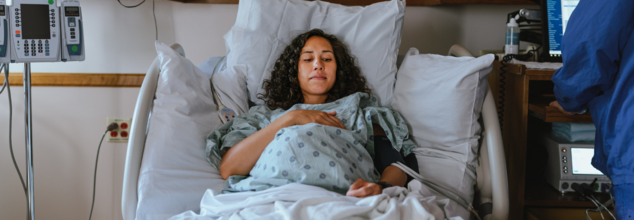- Health Conditions A-Z
- Health & Wellness
- Nutrition
- Fitness
- Health News
- Ayurveda
- Videos
- Medicine A-Z
- Parenting
- Web Stories
How A Pregnant Woman’s Weight Affects Her Baby's Risk For Infections?

Credits: Canva
Pregnancy is a critical period, not just for the physical development of the baby but also for laying the foundation of their long-term health. A new study released recently in BMJ Medicine establishes a strong link between maternal obesity in pregnancy and a child's elevated risk of being hospitalized for severe infection. The results are dramatic: children born to severely obese mothers are 41% more likely to be hospitalized for infections during their first year of life. That jumps to 53% between the ages of 5 and 15. These data put in sharp relief the imperative to learn more about how the weight of the mother might influence the immunity and health of subsequent generations.
Conducted by researchers at the University of Oxford, the longitudinal study tracked 9,540 births in Bradford, U.K., between 2007 and 2010. Their goal: to investigate long-term health outcomes in children born to overweight or obese mothers. More than half of the mothers in the study approximately 56% were found to be overweight or obese at the time of their pregnancy.
Infants of mothers with a BMI of 35 or more were especially at risk. The excess risk of infection was not entirely accounted for by the most frequent pregnancy complications of obesity, such as pre-term birth, which only explained 7% of the association. Other factors, including cesarean section (21%) and obesity in childhood at age 4 or 5 (26%), explained more of the excess risk.
Scientists suspect that something more is going on—perhaps related to how obesity in pregnancy might change a child's inflammatory system, immune system maturation, gut microbiota, or even gene expression, predisposing them to viral respiratory, gastrointestinal, and multisystem infections.
What Are The Risks Beyond Birth and Into Adolescence?
Infections were the leading cause of unnecessary hospital visits among the children in the study. Although infection in early childhood is usually viewed as a normal component of immune system maturation, the data indicates that children born to mothers with severe obesity were much more likely to experience infection that necessitated medical care.
These were not wimpy colds or sniffles—the admissions were for serious respiratory ailments, tummy bugs, and occasionally, intricate viral infections in multiple organ systems. The ramifications are two-fold: first, health costs and hospital capacity are impacted; second, children might suffer suboptimal health and interrupted development in early life.
Why Pre-Pregnancy Weight Matters?
Experts concur that the ideal window for intervention is before conception. Shedding even a moderate level of weight pre-pregnancy can greatly eliminate the chances of complications for both the mother and the child.
When a woman has a healthy body weight before pregnancy, she is laying the foundation for a healthier pregnancy, easier birth, and greater immunity in her child," says Victoria Coathup, lead author of the study and an Oxford epidemiologist.
Pregnancy has been termed a "teachable moment," with mothers being more receptive to adopting sustainable lifestyle modifications. Emphasis on diet, exercise, and metabolic well-being prior to conception can prove to have a greater impact than reactive intervention during or following pregnancy.
Why Weight Gain Monitoring During Pregnancy?
Tracking weight gain in pregnancy is equally crucial as achieving a healthy weight prior to pregnancy. During the initial prenatal visit, providers generally compute BMI and give recommendations for weight gain. Weighing regularly and checking fetal growth at future visits ensures both mother and baby remain on a healthy path.
Notably, not all departures from weight gain guidelines are troublesome. In the case of a pregnant woman who gains less than desired but whose fetus is growing well, rigid efforts to "catch up" are not always required. Attention should be directed toward nutrient-rich foods, rather than calorie consumption.
Impact on Labor, Delivery, and Beyond
Obesity not only affects the health of the baby—it also makes labor and delivery more difficult. Overweight and obese women tend to have longer labors, can experience difficulties with fetal monitoring, and are more likely to need a cesarean section.
Cesarean sections in obese women also have their risks: infections, excessive blood loss, and prolonged recovery times. Preventive measures such as compression devices to help prevent blood clot formation and planned pain management programs can alleviate these issues. However, being a healthy weight prior to conception continues to be the best risk reduction measure.
The message is not one of stigmatizing pregnancy weight but one of welcoming evidence-based practices that support maternal and infant health. From preconception education and prenatal nutrition counseling to lifestyle support postpartum, interventions need to be holistic and accessible.
Nutritionists advise emphasizing whole foods, lean protein, complex carbohydrates, and healthy fats, and exercising regularly, moderately. Support systems clinical and emotional alike help to maintain these habits throughout pregnancy and thereafter.
An Afternoon Nap Could Cost Middle-Age People Years Of Their Life

Sleep hygiene is something we should all keep up with constantly. While you may think you can skimp on sleep, your body needs it to keep functioning properly. Not only does sleep help us make sure our body runs all its functions smoothly, but it also keeps a sleep debt. Losing an hour of sleep may not seem like much, but your body requires 4 hours more to make up for that lost hour of sleep. Understanding this, many people opt for afternoon naps that span a few hours to help them recover lost energy. However, these naps are also not all safe for your health, especially for older adults.
An afternoon nap might seem like a good idea for middle-aged and older adults, but these short rests could actually come with a significant cost. New research suggests that certain napping habits might increase the risk of an early death. These findings are expected to be presented at an upcoming meeting of the American Academy of Sleep Medicine (AASM).
Napping Patterns and Early Death
Researchers explained that people who slept longer during the day, had irregular napping schedules, or napped more around midday and early afternoon faced a greater risk. This was true even when other health and lifestyle factors were considered. These findings challenge the popular idea of the "power nap."
For the study, researchers looked at information from over 86,500 people taking part in the UK Biobank, a long-term health research project. The sleep habits of these individuals were tracked for a week using wrist devices, and then researchers compared these habits to death records. On average, the participants were 63 years old when their napping was monitored.
What Did The Research Find?
Over an 11-year follow-up period, nearly 5,200 people in the study passed away. The results showed a higher risk of dying sooner for:
- People who usually took longer naps during the day.
- Those whose napping times changed often.
- Individuals who napped between 11 a.m. and 3 p.m.
This last point goes against current AASM guidelines, which suggest that adults limit themselves to "power naps" of no more than 20 to 30 minutes in the early afternoon. Researchers noted that naps longer than half an hour can actually make you feel groggy, canceling out any potential benefits.
What Does Healthy Sleep Look Like For Different Ages
According to the Mayo Clinic, healthy sleeping patterns differ according to age. The recommendations give are,Infants (4 to 12 months): Aim for 12 to 16 hours within a 24-hour day, including naps.
Toddlers (1 to 2 years): They need 11 to 14 hours in 24 hours, including naps.
Preschoolers (3 to 5 years): Target 10 to 13 hours within a 24-hour period, including naps.
School-aged Children (6 to 12 years): 9 to 12 hours every 24 hours is ideal.
Teenagers (13 to 18 years): 8 to 10 hours within a 24-hour period is recommended.
Adults: Most adults need 7 or more hours of sleep each night.
Other Factors Affecting Your Sleep Needs
Besides age, several other things can influence how much sleep you require,
Sleep Quality
It's vital not just how long you sleep, but how soundly. Frequent interruptions mean poor quality rest. Getting truly restful sleep is equally important as the total hours.
Previous Sleep Debt
If you haven't been getting enough sleep lately, your body needs extra rest. You'll have to make up for lost sleep to feel refreshed and function well.
Pregnancy
Hormonal shifts during pregnancy can make sleep difficult. Physical discomfort also contributes to poor sleep quality, leaving expectant mothers feeling less rested than usual.
Aging
While older adults need similar sleep amounts as younger adults, their sleep patterns change. They might sleep lighter, take longer to fall asleep, wake up more often, and have shorter sleep cycles at night.
This Drink Plays A Vital Role In Keeping Women Sharp As They Age

(Credit-Canva)
Your daily cup of coffee might offer more than just a morning pick-me-up; it could actually influence how well you age. A new study, done by researchers in the Harvard T.H. Chan School of Public Health, involving nearly 50,000 women, investigated the long-term effects of drinking tea, coffee, and cola. The research found that coffee, specifically caffeinated coffee, can positively impact women's mental and physical health as they get older.
How Coffee Might Help Older Women
Researchers discovered that drinking coffee regularly could help women stay mentally sharp, physically strong, and generally well as they age. But, these good effects were only seen with coffee that had caffeine. People who drank decaf coffee didn't get the same benefits, and neither did tea drinkers. Even worse, the study found that women who drank soda had a "much lower chance of aging healthily."
Researchers said that while past studies linked coffee to certain health outcomes, her study is the first to look at how coffee affects many parts of aging over 30 years. She added that the findings suggest caffeinated coffee, unlike tea or decaf, might uniquely help people age in a way that keeps both their mental and physical abilities strong. These results were shared at a big meeting for nutrition experts.
What the Study Looked At
Researchers said that study was strong because it included many people and followed them for 30 years. They also looked at different ways people age well and collected lots of details about their eating and lifestyle habits every four years.
The researchers looked at information from nearly 47,513 women who were part of a long-term health study since 1984. They figured out how much caffeine these women consumed by asking about their intake of common caffeinated drinks like coffee, tea, soda, and decaf coffee.
They defined "healthy aging" as living to age 70 or older, not having 11 major long-term diseases, being able to move well, having good mental health, not having thinking problems, and not complaining about memory issues. After 30 years, the team estimated how the chance of healthy aging changed for every 80 mg of caffeine (about one small cup of coffee) that people drank daily.
They also looked at specific drinks. Their early analysis also considered other things that could affect healthy aging, such as body weight, smoking, drinking alcohol, physical activity, education level, and how much protein was in their diet. The data showed that by 2016, 3,706 of the women met all the requirements for healthy aging. In their middle age (45-60), these women typically drank about 315 mg of caffeine per day. This is roughly the amount in three small cups of coffee or one and a half large cups by today's standards. More than 80% of that caffeine came from regular coffee.
Regular Coffee vs. Other Drinks
For the women who aged healthily, each extra cup of regular coffee per day was linked to a 2% to 5% higher chance of doing well in later life. This benefit went up to about five small cups of coffee per day (or about 2.5 cups using today's sizes). The scientists found no clear link between drinking decaf coffee or tea and a higher chance of healthy aging. However, every extra small glass of soda was linked to a 20% to 26% lower chance of healthy aging. This shows that not all caffeine sources are good for you.
AIDS Kills One Person Every One Minute, Says UN

Credits: Canva
While AIDS-related deaths have dropped to their lowest since 2004, the world is still battling against HIV. Amid all this, a United Nations statement highlights the serious global health issue that it has become. Despite the years of progress and scientific breakthroughs, the disease still claims one life every minute, and continues to the global toll of the epidemic.
More than 30 million people across the world at this moment are receiving life saving antiretroviral treatment. As per the UN Under Secretary-General Amina Mohammed, this is a testament to the power of multilateral action. Speaking at the UN General Assembly’s review of the global AIDS response, she called it a “clear example of multilateral success.”
Impact of Funding Cuts
However behind these figures, is also a fragile system that Mohammed too stressed upon. "Global commitment is fading, funding is falling, and HIV services are being disrupted." This could undo years of hard work. The Health and Me has previously reported that the United States government also abrupted halted funding for a seminal mRNA-based HIV vaccine study, just days before its scheduled start in March 2025.
Health and Me also reported on the US' plan to freeze all foreign assistance, along with the UNAIDS, which could become a global threat for HIV cases. The UNAIDS takes up less than 1% of the overall US budget and since Trump's re-election, audits for cost-cutting and executive orders, especially in the healthcare sector has changed the shape of how aid worked before.
UNAIDS Executive Director Winnie Byanyima noted that HIV infections have in fact decreased in the recent years. In 2023, 1.3 million new cases were recorded, which is a 60% decline since the virus peaked in 1995. However, with this abrupt cut off in funding, it has created a situation of "panic, fear and confusion" in many of the African countries which are hit hardest by AIDS.
Urgent Need for Action
“We cannot let short-term cuts destroy long-term progress,” Mohammed urged. She called for the funding crisis to be treated with urgency and seriousness. In many low- and middle-income countries, healthcare budgets are being squeezed by the burden of debt servicing. In sub-Saharan Africa, half of the countries spend more on debt payments than on healthcare.
To counter this imbalance, Mohammed advocated for debt relief, global tax reform, and stronger international collaboration. She also emphasized the need for national governments to show stronger leadership and invest in sustainable HIV financing models.
Human Rights Are Health Rights
Beyond finances, Mohammed pointed to another major challenge: attacks on human rights. Marginalised groups—including LGBTQ+ individuals, sex workers, and people who use drugs—are often criminalised or face violence, hate speech, and stigma. Such punitive laws and attitudes only push people further away from testing, treatment, and prevention services.
“Protecting health means protecting human rights,” Mohammed stated, urging nations to remove discriminatory laws and support inclusive healthcare services. She also highlighted the role of community-led organizations, many of which are now facing defunding. These groups are often closest to at-risk populations and play a crucial role in delivering services, especially in hard-to-reach areas.
The Road Ahead
While the global community has made historic progress, the fight against AIDS is far from over. “The end of AIDS is not a mystery,” said Mohammed. “But success is not guaranteed.” She reiterated that with the right investments, policies, and leadership, eliminating AIDS by 2030 is still within reach—but only if the world “keeps up the fight.”
© 2024 Bennett, Coleman & Company Limited

